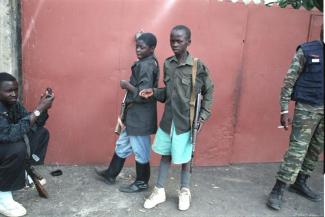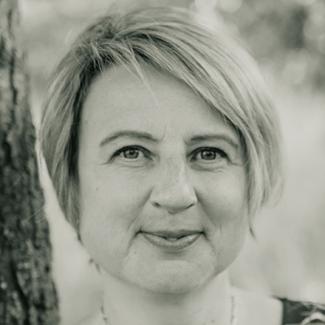Congo
“The state functions according to its entirely own logic”

What does the general situation look like at the moment with regard to the military and the rebels in the Congo?
Aside from the specific problems in eastern Congo, which have been smouldering for a long time, the situation in the entire country is very critical at the moment because of the looming presidential election. It is a source of great political tension. Everyone is affected by the uncertainty it is causing. The relevant actors include politicians from both the government and the opposition, as well as others like citizen movements and the Catholic Church, which have always played an important role in the Congo. No one knows what will happen in the next six to 12 months. People keep organising rallies, some of which have been violently suppressed, and there has been no shortage of political intrigue behind the scenes. The result is more and more restlessness among political and military actors at the provincial levels – especially in the historically unstable eastern part of the country.
What is the role of the regular army in the Congo?
From a bird’s eye view, it can be described as ambiguous. It’s like a chameleon that changes colour to match its environment. There are actually very large differences within the army, partly because of its size, but also because of its heterogeneous composition. Some units and commanders are doing a fantastic job. They have integrity, are patriotic and do not commit any human-rights violations. Then there is the exact opposite. There is also a great deal in between, so it is very difficult to make a general assessment. In statistical terms, it is true that the army is the actor committing the most human-rights violations in the Congo, but it also has more fighters than all armed groups taken together. It is hard to determine the precise number because official rosters are not up to date. Generally speaking, both the army and the police have a large presence in public life in the Congo. As they are usually not paid on time, it is actually quite common to see soldiers moonlighting on the streets. They may be selling vegetables or other goods. They recoup missing or delayed wages in other ways too, for instance by levying real or fake taxes on the streets. Such survival strategies are tolerated by civilians to a certain extent, as long as things remain balanced.
Why are there so many rebel groups in the Congo?
Like in every conflict zone, a lot of factors converge in the Congo. There are a few basic issues. The country is unbelievably large, the largest country by area in sub-Saharan Africa, and the infrastructure is extremely poor, which makes it difficult to access large portions of remote territory. In spite of much talk, the state has not collapsed, however. Its presence in daily life is visible and tangible. Even the smallest villages normally have a police officer, a soldier or some other kind of state official. But the state functions according to its entirely own logic. That is part of the problems that have emerged after decades of misrule and violence. The collapse of the Mobutu regime and external events like the Rwandan genocide and the flight of its perpetrators over the border sowed the seeds of the current situation. Ever since, there has been a cycle of violent mobilisation and moments when the brewing conflict boiled over. For example, the security situation usually deteriorates after elections, such as in 2006 and 2011. In both cases, strong rebel groups emerged that had the power to move beyond local conflicts and also exert pressure on the state. There have been other waves of violence following a similar pattern throughout the past 25 years.
Why has the UN mission, MONUSCO, had so little success thus far?
The UN mission and the broader ‘international community’ have not found the right answers to the crisis. For instance, most of the demobilisation programmes were well-meant, but they ultimately failed. Sometimes mistakes were made, and sometimes there was a lack of political will. Demobilisation programmes are unbelievably difficult to carry out. Moreover, the government has hastily integrated former rebels into the army, thus creating parallel structures within the military. Some former rebel leaders were made generals, but there was nowhere near enough room for everyone, which meant that many unsatisfied combatants were left behind. The result was great fragmentation of the rebel groups, especially in the past four or five years. Ten years ago, one could identify 20 or 30 groups, today there are about 120.
What do the rebel groups want?
Many of the armed groups are thinking more and more politically, even if their ambitions do not extend beyond the local level. Many are fighting for “customary power”, the power of traditional kings and leaders. Ethnic tensions matter too. Local elites often stir them up in political machinations. Generally speaking, politics and the economy are closely interwoven. A narrative has emerged that the rebels in the eastern Congo are primarily interested in the region’s commodities. Unfortunately, this fallacy renders it more difficult to understand what is really going on. Advocacy campaigns tend to emphasise the issue of “conflict minerals”. The truth is that various generations of combatants have had to finance their wars, and without a doubt they relied in part on mineral resources. But in regions without such resources, the rebels unlocked other sources of revenue, like marihuana cultivation or illegal taxes. The groups have always been pragmatic when it comes to finding ways to finance their operations. Warlords have definitely enriched themselves with raw materials, but Congolese and international entrepreneurs have done so to a far greater extent. Finally, the wars did not start because of minerals in the first place.
How difficult is it to identify the armed groups in the Congo?
Every act of violence and every clash has to be investigated case-by-case. Some occur for very opaque reasons. It is often very difficult to determine which group is responsible. Over the course of more than 25 years, many rebels have learned to operate skilfully behind the scenes. Political puppetmasters have also learned how to pull the strings in these conflicts without always being seen. For 16 years, there have been panels of experts at the UN who do nothing but carefully research who is behind what action, including massacres and illegal operations. I worked on such a panel from 2016 to 2017. Since last year, another project, called the Kivu Security Tracker, is compiling inventories of violence in the eastern Congo and tries to analyse who the drivers are. The project is being led by the New York University-based Congo Research Group.
You have identified 120 rebel groups. How did you go about it?
Because of the large number of groups, it takes a long time to identify them. Nevertheless, it is still easier to say who these groups and their leaders are, and in what regions they operate, than it is to research each group’s political ties and goals in great detail. Our latest version of the map for the first time includes brief biographies of every armed group. Unfortunately, the information is still rather superficial. You could conduct an in-depth research project for each of those groups. Still, we review all of our data multiple times and cross-reference it with other sources. The raw data was collected by a team of Congolese researchers operating across North and South Kivu.
Do local people know who is attacking them?
Combatants often cannot be identified by their uniforms, as numerous militias wear the same uniforms as the regular army. The reasons are the various phases of rebel integration into the army, the creation of new groups and the sale of individual uniforms. Of course, if a large group uses relatively new army uniforms and they all look the same, one could assume it is probably an official army unit. Many armed fighters, however, have only an army jacket or pants and otherwise wear civilian clothing. The language that the attackers speak often offers clues as to who they are, given that around 250 different languages are spoken throughout the Congo, not counting dialects. Moreover, there is a variety of factors, including behaviour and organisational structure, that might reveal the combatants’ identity. Generally speaking, victims and witnesses have a pretty good broader sense of who their attackers are – whether, for example, they are a Congolese Mai-Mai militia or Rwandan rebels.
Why are these horrific massacres of civilians taking place?
The worst thing, at this point, is the normalisation of violence. After some 25 years of cyclical civil war, there is at least one entire generation that knows little else besides conflict and violence. That presents an enormous problem for the future. With regard to the massacres, it is important to precisely determine who the victims and the perpetrators are, because there are various motives and dynamics. I have the sense that the number of violent incidents has increased in recent years, but the number of victims has declined in comparison with the larger clashes of the 2000s. At that time, there were large massacres that sometimes claimed the lives of hundreds of civilians. There are fewer such incidents today.
How can the Democratic Republic of the Congo, with help from the international community, get a grip on the situation?
I am convinced that serious demobilisation has to take place. International partners could play an important role in such an operation. A credible reform of the security sector is needed too, though its success would entirely depend on the attitude of the government. It is also very important to demilitarise the conflict, even though illegal imports of weaponry have decreased over the years. However, as of now there are simply too many arms in the country. We need a plan to confiscate and destroy them. Another important issue is the streamlining of reliable land rights and mining concessions et cetera in order to reduce related conflicts. There must also be a way to have a constructive influence on the current political impasse. Unfortunately, the opposition currently does not present a promising alternative to the government either. The diplomatic toolkit has not helped much either – US and EU sanctions, for instance, have had insignificant effects so far. A key question is whether the elections that were recently set for December 2018 will actually take place. Even if it will not be that easy to properly organise them from a technical standpoint, doing so is definitely in the range of the possible. The current political climate, however, does not inspire much overall optimism.
Christoph Vogel is a researcher currently based at the University of Zurich. He has been working on conflict dynamics in Central Africa for ten years, most recently as a member of the UN Group of Experts on the Democratic Republic of the Congo in 2016 and 2017. He shares insights at:
https://suluhu.org
chvogel@geo.uzh.ch
Link
Kivu Security Tracker:
https://kivusecurity.org








